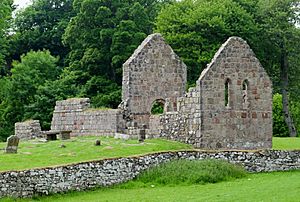Kingarth facts for kids
Quick facts for kids Kingarth
|
|
|---|---|
 Kingarth Hotel, Bute |
|
| OS grid reference | NS095563 |
| Civil parish |
|
| Council area | |
| Lieutenancy area | |
| Country | Scotland |
| Sovereign state | United Kingdom |
| Post town | ISLE OF BUTE |
| Postcode district | PA20 |
| Dialling code | 01700 |
| Police | Strathclyde |
| Fire | Strathclyde |
| Ambulance | Scottish |
| EU Parliament | Scotland |
| UK Parliament |
|
| Scottish Parliament | |
Kingarth (also known as Ceann a' Gharaidh in Scottish Gaelic) is a small, historic village. It is located on the Isle of Bute, which is an island off the coast of south-western Scotland. The village sits where two roads, the A844 and B881, meet.
Long ago, in the Early Middle Ages, Kingarth was a very important place. It was home to a monastery (a place where monks live and worship) and a bishopric (an area looked after by a bishop). It was also a special religious spot for Saints Cathan and Bláán (also known as Saint Blane).
Contents
Discovering St Blane's Church and Monastery
St Blane's Church is found north of Kilchattan Bay. This site was once the main religious centre for a group of people called the Cenél Comgaill. They were part of a larger kingdom known as Dál Riata. Kingarth is very close to the southern tip of the Isle of Bute. It's less than a kilometre from an old hill-fort called "Little Dunagoil." This fort might have been where the leaders of the Cenél Comgaill lived.
Exploring the Church Ruins
The remains of St Blane's Church are quite large. They are in a sheltered spot on a south-facing hill. From here, you can see beautiful views south towards the Isle of Arran. Most of the church ruins, like the nave (the main part of the church) and part of the chancel (the area around the altar), were built in the 1100s.
In the 1300s, the chancel was made bigger. The eastern part of the church was not built as strongly as the rest. You can still see a beautifully carved Romanesque chancel arch. This is a special archway that separates the chancel from the nave.
Churchyards and Ancient Burials
Around the church, there are two churchyards: an upper one and a lower one. In the past, men were buried in the upper churchyard and women in the lower. Both areas have many old, worn grave slabs. Some of these stones still show faint traces of decoration.
In the lower churchyard, you can see the foundations of another small building. People think this might have been a tiny chapel. The upper churchyard has a unique hogback tombstone. This type of stone looks a bit like a house or a hog's back. It dates back to the 900s or 1000s. This tombstone shows that the Norsemen (Vikings) who settled here eventually became Christians. The upper churchyard also holds the graves of bishops and abbots from the 7th and 8th centuries. You can also find the family burial plot of Sir William Macewen (1848-1924). He was a famous surgeon who lived nearby.
The Devil's Cauldron
There's a structure at the site known as the "Devil's Cauldron." Its walls are very thick, about 2.5 metres (8 feet) wide and 1.8 metres (6 feet) high. Experts believe it was either part of the original monastery or an even older dun (a type of fort).
Kingarth's Religious Importance Over Time
Around the 9th century, during Viking attacks, the main centre for Saint Bláán's followers likely moved. It probably went to Dunblane on the mainland for safety. This was similar to how other saints' relics were moved during that time.
Even with these changes, Kingarth remained an important religious site. It became one of only two parish churches on the Isle of Bute. The other was in Rothesay. Kingarth was part of the diocese of the Isles. Over the centuries, its connection to different religious groups and leaders changed. However, it continued to be a significant place of worship until after the Scottish Reformation.



